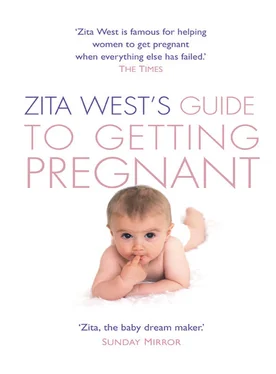Fertile Cervical Secretions after Ovulation
Some women notice what seems like highly fertile cervical secretions (wetter, transparent and stretchy) around the time they are expecting their period. This is because towards the end of the cycle there are some hormonal fluctuations between oestrogen and progesterone. As the progesterone level falls (due to the degeneration of the corpus luteum), the secretions appear more oestrogen – dominant. These secretions, however, should not be interpreted as a sign of fertility.
Predicting ovulation is not a precise science, but familiarity with your cervical secretions makes it a whole lot easier. The general advice is always to have lots of sex, rather than limiting it to a specific time – but when the pressure is on to conceive, sex can lose some of its spontaneity, which makes knowing the most fertile time of your cycle useful.
Try and keep some perspective about this, and don’t restrict sex to an exercise in conception – try and make sure you and your partner enjoy it for its own sake, too, and as a way to express your loving feelings for each other.
Cervical Secretions and Semen
If you find that you have more watery or raw egg white days than you would expect and that these often follow days or nights when you’ve had intercourse, then you may be mistaking seminal fluid for cervical secretions. They are quite similar, but remember that fertile cervical secretions are clear, stretchy and shiny. They can stretch a couple of inches without breaking. Semen may be more whitish and will break when pulled. Generally if you have had sex the night before, by lunchtime the following day there should be no trace of semen and you should be able to concentrate on your secretions.
Many women continue to experience a degree of cervical secretion after ovulation (necessary to keep the vagina moist and healthy) because the corpus luteum produces small amounts of oestrogen along with larger amounts of progesterone. However, this is no indicator of fertility: once ovulation has occurred for a cycle, it won’t occur again until the next one.
When you first start to take note of your secretions, they may be erratic and won’t follow the usual pattern of dry, sticky and white→clear and wet→sticky, white and dry again. Stick with it; it may take a while to work out.
Increasing cervical secretions
Evening Primrose oil (EPO) can play a role in the production of quality cervical secretions. EPO is an essential fatty acid (EFA) that contains gamma – linolenic acid (GLA), which is converted to a hormone – like substance called prostaglandin E1. EPO helps the body to produce raw egg white cervical secretions.
The recommendation is to take a supplement of EPO only during the first, pre – ovulatory time of the cycle, from menstruation to ovulation. This is because of the slight risk that EPO can cause uterine contractions, which you would want to avoid after ovulation. The recommended dose for the time between your period and ovulation should be 1,500 to 3,000mg per day (see Nutrition chapter for more details).
It may take a month or two to build up and produce the results you are looking for. If you are keeping a record of your fertility signs over the months, this will help you identify the first part of your cycle, prior to ovulation, when taking this supplement is advised. You will also know when you have ovulated, so you’ll know when to stop taking the EPO.
However, if you have had a diagnosis of high oestrogen levels, you will not know when you have ovulated and taking EPO will not be advised because of its oestrogenic properties. Far better, in this case, to visit a nutritionist and get an individually – tailored programme.
Other Ways to Increase Secretions
• Drinking plenty of water will increase your internal fluid balance and make any bodily secretion more fluid.
• Avoiding antihistamines, which reduce mucus secretions.
• Avoid high doses of vitamin C (more than 1,000mg per day).
Does Robitussin Really Work?
In chat rooms across the Internet, hundreds of women swear by taking 2 tablespoons of cough medicine that contains guaifenesin as the only active ingredient before ovulation. (Guaifenesin works as an expectorant to increase the liquidity of mucus production in the lungs, and elsewhere, to make coughing up phlegm easier.) It is believed that this makes cervical mucus more liquid and hospitable to sperm. While this may work in principle – and anecdotal evidence is eagerly repeated – there is little scientific evidence to back it up, although one 20-year-old study does indicate that it can be helpful in thinning out cervical mucus.
If you are going to take it, you would want to do so about five days before and including the day of ovulation. However, when you are trying to conceive it’s worth thinking about the effects of any medication that you take, even those bought over the counter. There are some women who have allergic reactions to guaifenesin, although it is generally considered safe. Make sure there are no other ingredients in the cough mixture that could be harmful – check with your pharmacist.
Progesterone and Your Cycle
While oestrogen dominates the first phase of your cycle, progesterone dominates your second, post – ovulatory or luteal phase of your cycle. Before ovulation, progesterone is present only in small amounts. After ovulation, progesterone, produced by the corpus luteum, is present in higher amounts.
Progesterone has many roles:
• It makes the lining of your uterus soft and spongy, with increased blood flow, so that a fertilized egg can latch on to it and implant.
• It is needed to support and continue a pregnancy by ensuring that the lining of the womb remains intact and a woman doesn’t have a period.
• It also causes your Basal Body Temperature (BBT) to rise after ovulation so that it is measurable with a BBT thermometer.
Although some women choose to record their waking temperature, many of the women I see get so stressed out by this method that I do not normally recommend it. Nor is this method recommended by new NHS guidelines – for three reasons:
1. Progesterone causes a rise in BBT (that is, waking temperature – your temperature after you have been resting for at least three hours and before you get out of bed).
2. Your temperature does not rise until AFTER ovulation – by which time it is too late to try to conceive.
3. It can be very stressful having a daily reminder when you first wake up that you are not pregnant yet.
As I said earlier, generally I would not advise women to record their temperature. There may be an appropriate role for taking your temperature if you have been advised by a trained fertility awareness practitioner that this would be beneficial – for example to provide a more objective marker and to determine the length of the luteal phase of your cycle. Otherwise – don’t worry about it.
Having said this, taking their temperature does give some women reassurance that they are ovulating. Trying this for a month when you are first trying to conceive will do no harm, but not month in, month out – it causes too much stress. Many factors affect your temperature – a low – grade fever, alcohol, fewer than three hours’ sleep, air travel and electric blankets – so it’s really not the best indicator.
Because progesterone is the hormone designed to prepare the body for pregnancy, birth and breastfeeding, its effects are linked to these processes. Breasts tend to swell a little under its influence, and can become tender for many women during the second phase of their cycle (and during early pregnancy, if it occurs).
Читать дальше












